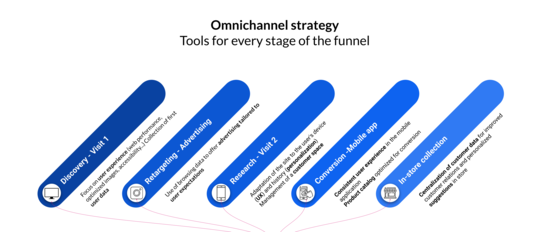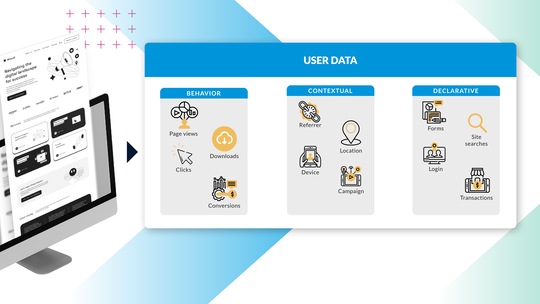The Top Customer Data Platform Use Cases

Customer data platforms (CDP) tackle many of the problems of traditional data management. Organizations can struggle to maximize the value of their data when it is siloed in different systems. Scattered data makes it difficult to get an accurate understanding of customer behavior. It is equally difficult to leverage this data to improve customer engagement.
CDPs help solve this problem by combining data ingestion, segmentation, data analytics, reporting, and activation into a single solution. With such robust functionality, CDPs have a wide range of applications. In this post, we’ll examine the most popular customer data platform use cases and how they can benefit your business.
Here’s what we’ll cover:
- Creating a single customer view
- Creating personalized experiences
- Audience targeting for paid advertising campaigns
- Connecting online and offline channels
- CDP as a data source for other marketing systems
- Customer scoring for better predictive analytics
- Countless CDP use cases with jCustomer
Creating a single customer view
Customer data platforms unify data gathered from multiple sources to create a single view of each of your customers. This data includes first-party data as well as any data collected from second- and third-party sources. Data is organized into a customer profile that contains a unique identifier.
Once a profile is created it can be associated with tags and predefined goals to facilitate segmentation. With complete profiles for your customers that pull information from across your application ecosystem, it is easier for marketers to create highly-relevant audience segments. Data is consolidated and updated in real-time to ensure you always have an accurate view of the customer.
Creating personalized experiences
You can use a CDP to segment customers based on behavioral data and other characteristics. These segments allow you to create highly personalized experiences throughout the entire customer journey. You can connect a CDP to a personalization engine through APIs or some platforms, like jExperience, have a CDP built directly into a personalization engine. With the data from the CDP, the personalization engine can surface the most relevant content for each user.
For example, let’s say a visitor views multiple products from the same category on your ecommerce site before exiting. On their next visit, you could show a promotional offer for that product category. Or you could have the homepage show that category instead of a generic assortment.
You will have the ability to export the data from the CDP to use for personalizing the customer experience across different touchpoints. For example, you can connect a CDP to your email marketing technology. With tags from the CDP, you can create refined segments for your email marketing list. When sending your weekly newsletter, instead of sending a generic message to everyone, you can personalize the message content to show relevant products based on the segment.
Audience targeting for paid advertising campaigns
You can use the data from your CDP for better targeting with your marketing campaigns on popular advertising platforms like Google and Facebook. For example, you can export an audience segment from your CDP and add the segment as a custom audience to a Facebook campaign. You could also use the segment to create a lookalike audience to expand your reach to similar users.
With more refined audience targeting, you can create targeted campaigns. Using the data from your CDP, you can customize different parts of your ad creatives such as headlines, calls to action, colors, and images based on the customer’s interactions with your business.
Connecting online and offline channels
Marketing teams can use a CDP to connect data between online and offline channels. For example, by integrating a CDP with your point of sale (POS) system you can collect valuable data from in-store purchases. These buyers will receive a unique profile like your online customers and you can use the data to enhance future shopping experiences.
CDP as a data source for other marketing systems
You can use your CDP as a data source for other marketing platforms. CDPs offer easy connections to other systems via API, database queries, native integrations, or third-party integrators. This could be a CRM, analytics platform, email autoresponder, or other marketing automation software. You can even connect other data management platforms (DMP) to create a bi-directional flow of data.
The CDP serves as the center of integration for all the systems. New data is added to the CDP along with any changes to customer profiles. These changes will then automatically reflect across your different systems, saving you the hassle of having to update each individually.
Customer scoring for better predictive analytics
With a CDP, you can use a scoring system to better predict the future actions of your customers. This predictive data allows you to assess the probability that a customer buys, visits a certain page, opens an email, and more. You can adjust the scoring system based on a variety of conditions to improve its accuracy.
Countless CDP use cases with jCustomer
Built on Apache Unomi, jCustomer is a headless open-source CDP designed to provide actionable data for shaping customer experiences. The software collects data from different silos, allowing you to manage any event across your DXP from a single user-friendly dashboard. Customer profiles are updated in real-time and GDPR capabilities ensure that you always stay compliant with data privacy regulations.
If you want to maximize the value of your data and create meaningful customer interactions across your omnichannel experience, there are plenty of use cases for a robust CDP like jCustomer.


